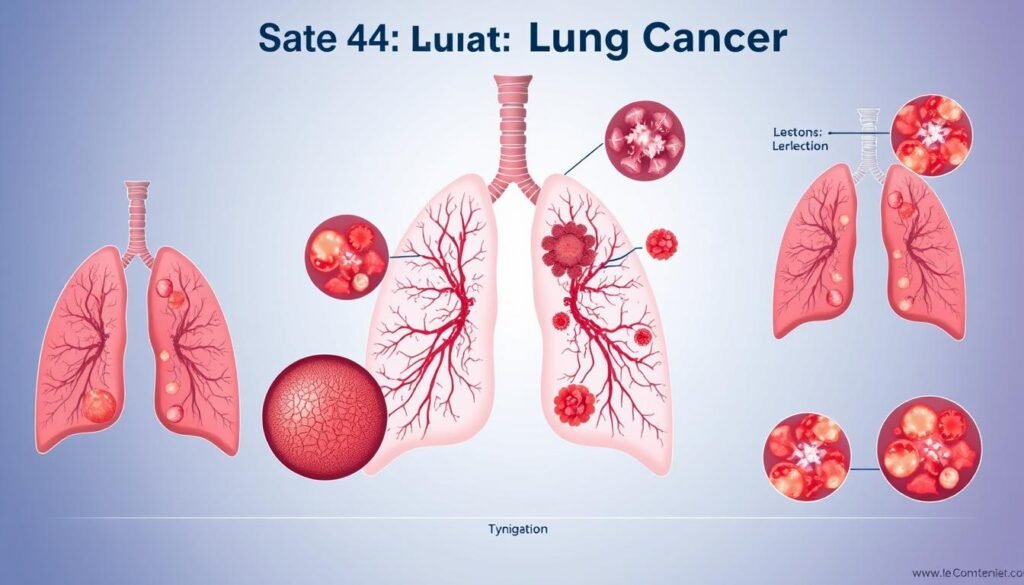About 5% of people with stage 4 lung cancer live for five years or more. This fact shows how serious the illness is at this late stage. It’s very important for patients and their loved ones to understand what to expect. They need to know about treatment options and how likely they are to survive. This helps them plan and deal with this tough time.
The cancer can spread to both lungs, nearby areas, and far-off organs as it gets worse. This makes symptoms more severe and treatments harder to do. Knowing about possible outcomes and treatments helps families get ready for what’s coming. They can face the difficult path ahead with more knowledge and support.
Key Takeaways
- Stage 4 lung cancer has a five-year survival rate of just 5%.
- Understanding treatment options can enhance quality of life and outcomes.
- Survival rates vary significantly based on factors like age and sex.
- Palliative care plays a crucial role in managing symptoms and improving comfort.
- Clinical trials may provide additional options and hope for patients.
Understanding Lung Cancer Staging
Lung cancer staging is vital for understanding how far cancer has spread. It uses the TNM system, set by the American Joint Committee on Cancer. This system looks at tumor size (T), spread to lymph nodes (N), and metastasis (M).
There are four stages of lung cancer, with stage 4 being the most serious. Stage 4 has two parts: 4A and 4B. Stage 4A means cancer has spread to the other lung or close areas like the pleura. It might also reach far-off lymph nodes or organs such as the liver or brain. Stage 4B shows cancer has moved to many areas outside the chest, affecting distant parts of the body.
Knowing the stage of lung cancer is critical for treatment and predicting survival rates. Stage 4 lung cancer’s 5-year survival rate is about 1%, the lowest among all stages. Clear staging helps in choosing the best treatment to manage symptoms and improve life expectancy.
What is Stage 4 Lung Cancer?
Stage 4 lung cancer is the most severe form, indicating that the cancer has spread. It reaches other vital organs like the liver, bones, or brain. This stage changes how doctors can treat the cancer and what they expect next. It’s divided into non-small cell lung cancer (NSCLC) and small cell lung cancer (SCLC).
Most lung cancer cases, around 80-85%, are non-small cell. NSCLC can evolve to stage 4. At this point, it’s broken down further into sub-stages 4A and 4B. The difference is how much it has spread.
Small cell lung cancer, on the other hand, is categorized differently. It’s described as limited or extensive. The extensive form is similar to stage 4. Here, treatment becomes very tough. Those facing stage 4 lung cancer are often looking at palliative care options instead. Their main goal is quality of life.
The survival rates for stage 4 lung cancer are low. Only about 9% of NSCLC patients survive five years post-diagnosis. For SCLC, the number drops to 3%. It’s crucial for both patients and their loved ones to grasp what this stage means.
Symptoms Associated with Stage 4 Lung Cancer
When lung cancer gets to its advanced stage, the signs become more apparent. These lung cancer symptoms include a lasting cough. Also, coughing up blood, chest pain, shortness of breath, and feeling very tired are things to watch out for.
Other symptoms like losing weight without trying and getting sick often may happen too. Your body might be fighting something serious. You could also see swelling in parts of the body or skin changes as the cancer grows.
If the cancer spreads, the symptoms depend on where it goes. Jaundice can show up if the liver is affected. Problems with the brain can lead to headaches or other issues. It’s important to catch these common signs early for better treatment.
The following table shows some main symptoms of stage 4 lung cancer:
| Symptom | Description |
|---|---|
| Persistent cough | A cough that doesn’t stop, getting worse over time. |
| Hemoptysis | When you cough up blood. It’s a sign to seek help right away. |
| Chest pain | This pain gets worse when you breathe deeply or do some activities. |
| Shortness of breath | You feel out of breath, mostly when you’re moving or exercising. |
| Fatigue | You’re so tired that it’s hard to do everyday things. |
| Unexplained weight loss | When you lose a lot of weight without trying to. |
| Frequent infections | You might get things like bronchitis or pneumonia over and over. |
| Neurological symptoms | Signs like headaches that suggest the brain might be affected. |
It’s key to see a doctor if you notice these signs. The right treatment can make a big difference in how you feel. For more help on dealing with this, check out advanced lung cancer.
Types of Lung Cancer at Stage 4
Stage 4 lung cancer has two types: non-small cell and small cell lung cancer. Each type affects how doctors treat the cancer and the patient’s chances of survival.
Non-small cell lung cancer (NSCLC) is the more common type, making up about 80-85% of all cases. It divides into two groups at stage 4: 4A and 4B. These groups are based on the size of the tumor, if it has spread to lymph nodes, and if it has reached other organs. Sadly, for advanced NSCLC, the 5-year survival rate is about 9%.
Small cell lung cancer (SCLC) is less common but more aggressive. It accounts for 15-20% of lung cancer cases. SCLC is mainly identified by how far it has spread: limited or extensive. The chance of living five years with distant SCLC is very low, at 3%. This shows the urgent need for treatments that specifically target these different lung cancers.

| Type of Lung Cancer | Stage 4 Survival Rate |
|---|---|
| Non-Small Cell Lung Cancer (NSCLC) | 9% |
| Small Cell Lung Cancer (SCLC) | 3% |
The survival rates between the two lung cancer types highlight why early detection and personalized treatments are crucial. Knowing these differences helps patients choose the best care options and can lead to a better life quality.
Lung Cancer Stage 4 Survival Rates
It’s vital to understand stage 4 lung cancer survival rates for patients and their families. At this stage, cancer has spread beyond the lungs, making the prognosis challenging. The five-year survival rates for stage IV lung cancer are low. This emphasizes the need to look into different factors that affect prognosis.
Five-Year Relative Survival Rate
The five-year survival rate for non-small cell lung cancer (NSCLC) is under 20%. Every year, about 70,000 to 105,000 new patients are diagnosed with stage IV NSCLC globally. Sadly, 25% to 30% of these patients may not survive past three months after their diagnosis. However, those who survive beyond three months have a one-year survival rate of about 74%. This drops to 16% for two years and 5% for five years.
Factors Affecting Survival Rates
Many factors affect the prognosis of stage IV lung cancer patients. Important aspects include:
- Age and overall health of the patient
- Gender, with 42% of survivors being female and 58% male
- The subtype of lung cancer
- How the patient responds to treatments like chemotherapy and targeted therapy
- Performance status and other clinical indicators
Patients who receive treatments like platinum-based chemotherapy have a median survival of 23.3 months. This is compared to 16.1 months for those who do not undergo treatment. These facts highlight the importance of considering treatment options to improve survival rates. Knowing these factors can help patients and families make better decisions during this tough time.
Treatment Options for Stage 4 Lung Cancer
Stage 4 lung cancer treatment often involves various strategies. These aim to slow down the disease and better the quality of life. People can choose from treatments like chemotherapy, targeted therapy based on genetic tests, and immunotherapy. This last option boosts the immune system to fight cancer.
Chemotherapy and Targeted Therapy
For stage 4 non-small cell lung cancer, the most common chemotherapy uses cisplatin or carboplatin with gemcitabine. Chemotherapy is important for many people. It tackles cancer’s growth directly. Erlotinib, gefitinib, or osimertinib are options for those with EGFR-positive lung cancer. Crizotinib helps patients with ALK-positive NSCLC.
Targeted therapy is key nowadays. Sotorasib works for patients with KRAS G12C-positive NSCLC. Those with BRAF V600E mutations might get dabrafenib and trametinib. Larotrectinib targets TRK fusion-positive cases. MET exon 14 skipping mutations respond to tepotinib or capmatinib. Gavreto and Retevmo are for RET fusion-positive NSCLC. Sometimes, doctors combine treatments, like bevacizumab with carboplatin and paclitaxel, for personalized care.
The Role of Immunotherapy
Immunotherapy is exciting for many patients. They might use Pembrolizumab, Atezolizumab, Nivolumab, Ipilimumab, or Cemiplimab. These treatments boost the body’s defenses against cancer. It offers an alternative to traditional therapies for several patients.
It’s crucial for patients to work closely with their healthcare teams. Together, they make a treatment plan that fits the patient’s health and cancer type.
Palliative Care and Quality of Life
Palliative care is crucial for those with stage 4 lung cancer. It focuses on quality of life and symptom management. This type of care is for anyone with lung cancer, no matter their prognosis. Starting palliative care early, right at the beginning of the cancer journey, is helpful.
Teams of doctors, nurses, social workers, and other professionals offer full support. They help with pain relief, emotional support, and counseling. This care goes along with cancer treatment, not just at the end of life. It eases distress by tackling symptoms like pain, fatigue, and anxiety.
Support includes a variety of services such as:
- Pain management
- Nutritional counseling
- Emotional and psychological support
- Guidance for treatment decisions
- Integrative services like massage and mindfulness
Palliative care happens in many places, including hospitals and homes. It makes life better for lung cancer patients by meeting physical and emotional needs during treatment.
| Type of Support | Description |
|---|---|
| Pain Relief | Utilizes medications and therapies to manage physical discomfort. |
| Symptom Management | Focuses on relieving symptoms such as breathlessness and fatigue. |
| Counseling | Offers emotional support to patients and families coping with cancer. |
| Treatment Guidance | Assists in making informed decisions regarding treatment options. |
Clinical Trials: A Chance for Hope
Clinical trials are crucial for patients with stage 4 lung cancer. They offer access to new treatments not yet widely available. These studies test new drugs, therapies, or approaches to improve patient outcomes. This research is key to advancing lung cancer treatment and knowledge.
A study from June 2008 to June 2009 at the Clinic for Pulmonary Oncology in Serbia was important. It enrolled 59 patients, with 48 (81.4%) men and 11 (18.6%) women. Over half, 50.8%, had stage IV non-small cell lung cancer (NSCLC).

In the study, participants had different lung cancers. 54.2% had squamous cell, 27.1% had small cell, and 18.6% had adenocarcinoma. They got to try new treatments, with 28.8% in phase II and 71.2% in phase III trials.
Sara Whitlock’s story highlights the trials’ importance. Diagnosed with a low survival chance, she’s lived nine years thanks to targeted therapy trials. One drug, selpercatinib (LOXO-292), offered her remarkable benefits. It’s hopeful for patients with certain lung cancer genetic mutations.
Clinical trials offer not just hope for better health, but also aid in lung cancer research. Patient participation shapes future cancer treatments and standards of care. It improves cancer treatment for everyone.
End-of-Life Care Considerations
End-of-life care is important for stage 4 lung cancer, focusing on comfort and dignity. Hospice care is key, offering support to patients and families. Those eligible for hospice are often in their final six months of life.
Families benefit greatly from emotional and spiritual support during this tough time. Caregiver stress and fatigue can affect their health, making support for the whole family essential. Talking about care plans early ensures treatments match the patient’s wishes.
Hospice care includes many services like medication help and financial planning. Social workers guide families, making sure patients get good symptom and pain management.
Hospice improves patients’ quality of life. It offers inpatient care for caregiver breaks and continuous bedside care for acute symptoms. These practices give families peace of mind.
After a patient passes, hospice helps survivors for 13 months. This support helps them through their grief, building a sense of community in hard times.
| Service | Description |
|---|---|
| Inpatient Care | Up to 5 days of care when the caregiver needs a break. |
| Continuous Care | 24-hour support for acute symptom management. |
| Emotional Support | Help for families coping with grief and stress. |
| Financial Planning Assistance | Guidance on financial options and resources available during hospice care. |
| Medication Management | Coordination and supply of necessary medications and medical equipment. |
Lung Cancer Stage 4 Survival: What to Expect
When you find out you’re dealing with stage 4 lung cancer, it’s a time for preparation. It’s already quite advanced at this stage. This brings many emotional and physical challenges to both patients and their families.
As the disease gets worse, a variety of symptoms appear. Talking often with doctors about treatments and how to ease symptoms is crucial. This way, patients and families can choose the best care confidently.
Now, support systems are key. Joining support groups provides encouragement and advice from others who understand. They offer help with the emotional and mental aspects of advanced cancer.
Treatment has come a long way recently. Immunotherapy and targeted therapies are new options. They offer hope by extending life and making it better for some.

Even with tough odds, the experiences of those with lung cancer vary a lot. Making the most of treatment and asking for second opinions can help. It’s key to remember that about 70% of lung cancer cases are found late. This shows why regular doctor visits are so important.
To sum up, knowing all about the disease and the available support is vital. With hope, determination, and the right treatments, patients can improve their journey. Despite the challenges, there is always hope.
Conclusion
Lung cancer at stage 4 poses significant survival challenges. The statistics might look scary, but there’s still hope. Understanding this stage deeply can reveal the benefits of combining treatments. For example, research shows combining chemotherapy and natural extracts, like Viscum album L., can extend survival. It indicates a median survival time of 17 months for patients receiving these combined treatments. This underlines the value of comprehensive care.
It’s crucial for patients and families to be aware of lung cancer. Education and support help them make better decisions for their care. Organizations like the American Lung Association play a key role. They help fight treatment gaps among different racial and ethnic groups. This ensures everyone has equal access to care and support.
Staying in touch with healthcare teams can improve a patient’s experience with lung cancer. This article aims to help by providing valuable insights on survival. It encourages conversations and empowers patients to seek the best care. For more information, check the key findings on lung cancer. They highlight the critical need for early screening and action.